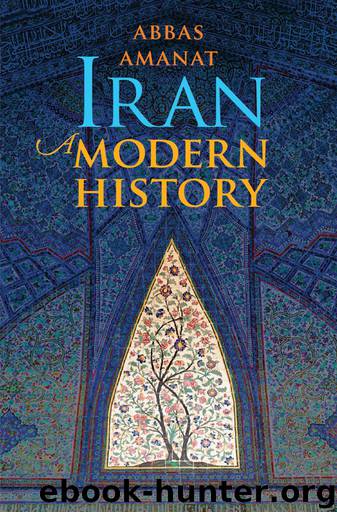Iran by Abbas Amanat

Author:Abbas Amanat [Amanat, Abbas]
Language: eng
Format: epub
Publisher: Yale University Press
Published: 2017-10-25T04:00:00+00:00
Figure 9.3. Marshal Voroshilov shows the Stalingrad sword to Franklin Roosevelt during the Tehran conference on November 28, 1943. Winston Churchill and Joseph Stalin look on. No Iranian official attended the conference, held at the Soviet embassy in Tehran.
© Imperial War Museum, London.
The central government’s answer to these mounting problems was at best conciliatory, occasionally draconian, and often ineffective. The ministerial posts were given to ranking bureaucrats, landowners, and secular professionals educated in the Reza Shah era, whereas premiership often went to notable members of the old divan families. Short-lived and lacking a viable constituency, the governments in the postwar era were caught between the conflicting demands of a revitalized Majles, which soon turned into an arena of personal and ideological rivalries, the whims and wishes of the court, and the real or assumed influence of the occupying powers. In the twelve years between 1941 and 1953 there were fifteen governments in office and many more instances of reshuffling.
With economic problems looming large, the situation called for new sources of revenue beyond taxation and the meager oil income. The agrarian tax base was small, the village population impoverished, and the state endemically lacked the means of collecting taxes. In the 1943 fiscal year the deficit ran close to 90 percent of the total government revenue. By 1947 it was reduced to 45 percent, thanks in part to reform measures introduced by Arthur Millspaugh and his team of American financial advisers who had been employed for a second time between 1942 and 1945 to overhaul taxation and fiscal policies. Yet a chronic shortage of funds for development was serious enough to persuade successive governments to seek foreign aid, primarily from the United States, the only member of the Allied forces capable of helping Iran. Financial assistance, however, came with strings attached, mostly in the form of military assistance and advisory missions as a counter to growing Soviet influence. An increase in Iran’s oil revenue, with the goal of complete nationalization of Iran’s oil industry, thus seemed a viable alternative. As early as 1946 such demands were audible, even though almost from the start they ran up against the jealously guarded British interests of the shrinking British Empire.
Fragile governments, tribal insurrections, and expansion of the pro-Soviet network of sympathizers and activists in turn contributed to the growth of the armed forces as the guarantor of internal security. After the fiasco of dismantling the Iranian army in mid-1941, the armed forces were reorganized in early 1942 and after the war with the partial assistance of US advisers and the purchase of surplus US military hardware. Anxious to display its might and recoup its sinking prestige, the Iranian military command, schooled in the brutish discipline of the Reza Shah era, reacted severely to public protests. In December 1942 a Tudeh-inspired crowd attacking the Majles and looted public buildings demanding the removal of the prime minister Ahmad Qavam and his government on the charge of pro-American sympathies. The Qavam government, declaring martial law, allowed the
Download
This site does not store any files on its server. We only index and link to content provided by other sites. Please contact the content providers to delete copyright contents if any and email us, we'll remove relevant links or contents immediately.
| Africa | Americas |
| Arctic & Antarctica | Asia |
| Australia & Oceania | Europe |
| Middle East | Russia |
| United States | World |
| Ancient Civilizations | Military |
| Historical Study & Educational Resources |
Empire of the Sikhs by Patwant Singh(22928)
The Wind in My Hair by Masih Alinejad(5019)
Rise and Kill First by Ronen Bergman(4670)
The Templars by Dan Jones(4611)
The Rape of Nanking by Iris Chang(4117)
12 Strong by Doug Stanton(3470)
Blood and Sand by Alex Von Tunzelmann(3112)
The History of Jihad: From Muhammad to ISIS by Spencer Robert(2552)
Babylon's Ark by Lawrence Anthony(2516)
No Room for Small Dreams by Shimon Peres(2303)
The Turkish Psychedelic Explosion by Daniel Spicer(2291)
Gideon's Spies: The Secret History of the Mossad by Gordon Thomas(2289)
Inside the Middle East by Avi Melamed(2289)
Arabs by Eugene Rogan(2247)
The First Muslim The Story of Muhammad by Lesley Hazleton(2200)
Come, Tell Me How You Live by Mallowan Agatha Christie(2111)
Bus on Jaffa Road by Mike Kelly(2089)
Kabul 1841-42: Battle Story by Edmund Yorke(1970)
1453 by Roger Crowley(1930)
